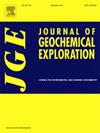寒区湖泊冰期FeP耦合对沉积物中砷的影响
IF 3.3
2区 地球科学
Q1 GEOCHEMISTRY & GEOPHYSICS
引用次数: 0
摘要
铁(Fe)的氧化还原行为显著影响砷(As)的生物地球化学循环,铁矿物是磷(P)的主要储集层。a的循环与它的物种有内在的联系。然而,FeP耦合对湖泊沉积物中As物种的影响在很大程度上仍然未知,特别是在冰期。本研究的新颖之处在于利用基于沉积物中As、Fe和P物种以及环境因子监测的PLS-SEM模型,探索FeP耦合对冰期As物种形成的影响。结果表明,FeP偶联占As形态变异的95.7%,在As的转化和分配中起着关键作用,特别是在含有吸附As的不稳定As池、与铁种密切相关的中等不稳定As池和黄铁矿共沉淀As中。FeP耦合对非晶铁氧化物和结晶铁氧化物的还原转变和再分布有显著影响,进而影响As的吸附-解吸过程。这种相互作用随后影响铁和磷的形态,以及砷的释放和生态毒性。值得一提的是,交换性磷、铁结合磷组分和有机磷组分(OP)被确定为FeP耦合对as形成影响的主要磷种。有趣的是,OP在FeP偶联对As的影响中也发挥了主要作用,在有机物矿化过程中可能释放吸附在结晶铁氢氧化物上的As。结果强调了铁(氢)氧化物和磷在控制砷分配中的重要性,其中铁(氢)氧化物在磷的行为及其与砷的相互作用中尤为重要。本研究为沉积物-水体系统中砷的循环和磷、砷的富集提供了新的思路,为面临砷污染和富营养化双重风险的沉积环境的环境监测和修复提供了参考。本文章由计算机程序翻译,如有差异,请以英文原文为准。

The effect of FeP coupling on arsenic species in sediments during the ice-bound period of lakes in cold regions
The redox behavior of iron (Fe) significantly impacts the biogeochemical cycle of arsenic (As), with iron minerals serving as major reservoirs for phosphate (P). The cycle of As inherently associates with its species. However, the effect of Fe![]() P coupling on As species in lake sediments remain largely unknown, especially during the ice-bound period. The novelty of this study is to explore the effect of Fe
P coupling on As species in lake sediments remain largely unknown, especially during the ice-bound period. The novelty of this study is to explore the effect of Fe![]() P coupling on As speciation during an ice-bound period using PLS-SEM model based on As、Fe and P species as well as environmental factors monitoring in sediments. Our findings revealed that Fe
P coupling on As speciation during an ice-bound period using PLS-SEM model based on As、Fe and P species as well as environmental factors monitoring in sediments. Our findings revealed that Fe![]() P coupling accounts for 95.7 % of As speciation variability, playing a pivotal role in As transformation and partitioning, particularly in labile As pool that contained adsorbed As, moderately labile As pool that closely related to iron species, and pyrite-coprecipitated As. The significant influence of Fe
P coupling accounts for 95.7 % of As speciation variability, playing a pivotal role in As transformation and partitioning, particularly in labile As pool that contained adsorbed As, moderately labile As pool that closely related to iron species, and pyrite-coprecipitated As. The significant influence of Fe![]() P coupling on the reductive transformation and re-distribution of amorphous and crystalline iron oxides, which in turn affects As adsorption-desorption processes. This interaction subsequently influences the speciation of Fe and P, as well as the release and ecotoxicity of As. Notably, exchangeable phosphorus, iron-bound P fraction and organic P fraction (OP) were identified as the primary P species mediating the effects of Fe
P coupling on the reductive transformation and re-distribution of amorphous and crystalline iron oxides, which in turn affects As adsorption-desorption processes. This interaction subsequently influences the speciation of Fe and P, as well as the release and ecotoxicity of As. Notably, exchangeable phosphorus, iron-bound P fraction and organic P fraction (OP) were identified as the primary P species mediating the effects of Fe![]() P coupling on As speciation. Interesting, OP also play the major role in the effect of Fe
P coupling on As speciation. Interesting, OP also play the major role in the effect of Fe![]() P coupling on As species, potentially releasing As adsorbed on crystalline Fe hydroxides during organic matter mineralization. Results emphasize the importance of Fe(hydro)oxides and P in controlling As partitioning, with iron (hydro)oxides being particularly critical in P behavior and its interaction with As. This work provides insights into the cycling of As and the enrichment of P and As in sediment-water systems, providing a reference for environmental monitoring and remediation in sedimentary environments facing dual risks of As pollution and eutrophication.
P coupling on As species, potentially releasing As adsorbed on crystalline Fe hydroxides during organic matter mineralization. Results emphasize the importance of Fe(hydro)oxides and P in controlling As partitioning, with iron (hydro)oxides being particularly critical in P behavior and its interaction with As. This work provides insights into the cycling of As and the enrichment of P and As in sediment-water systems, providing a reference for environmental monitoring and remediation in sedimentary environments facing dual risks of As pollution and eutrophication.
求助全文
通过发布文献求助,成功后即可免费获取论文全文。
去求助
来源期刊

Journal of Geochemical Exploration
地学-地球化学与地球物理
CiteScore
7.40
自引率
7.70%
发文量
148
审稿时长
8.1 months
期刊介绍:
Journal of Geochemical Exploration is mostly dedicated to publication of original studies in exploration and environmental geochemistry and related topics.
Contributions considered of prevalent interest for the journal include researches based on the application of innovative methods to:
define the genesis and the evolution of mineral deposits including transfer of elements in large-scale mineralized areas.
analyze complex systems at the boundaries between bio-geochemistry, metal transport and mineral accumulation.
evaluate effects of historical mining activities on the surface environment.
trace pollutant sources and define their fate and transport models in the near-surface and surface environments involving solid, fluid and aerial matrices.
assess and quantify natural and technogenic radioactivity in the environment.
determine geochemical anomalies and set baseline reference values using compositional data analysis, multivariate statistics and geo-spatial analysis.
assess the impacts of anthropogenic contamination on ecosystems and human health at local and regional scale to prioritize and classify risks through deterministic and stochastic approaches.
Papers dedicated to the presentation of newly developed methods in analytical geochemistry to be applied in the field or in laboratory are also within the topics of interest for the journal.
 求助内容:
求助内容: 应助结果提醒方式:
应助结果提醒方式:


